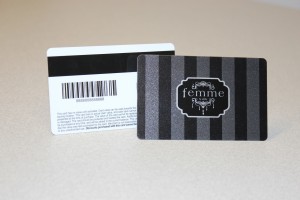What You Need to Know About Barcodes on Plastic Cards
 I frequently get questions about plastic card printing and how it works with magnetic stripes and barcodes. Most businesses today want to include this technology on their plastic cards (such as gift cards and loyalty cards) because it’s perfect for tracking customer IDs, sales, marketing information and more.
I frequently get questions about plastic card printing and how it works with magnetic stripes and barcodes. Most businesses today want to include this technology on their plastic cards (such as gift cards and loyalty cards) because it’s perfect for tracking customer IDs, sales, marketing information and more.
A few weeks ago, I wrote about mag stripes, so today I’ll share this basic Q&A about barcodes. If you’re considering this option for your next order of plastic cards, I hope this helps.
Q&A on Barcode Technology and Plastic Card Printing
Q: How is a barcode created and how does the scanner read it?
A: QR codes are all the rage today, right? You use a smartphone app to scan the QR code image, and it takes you to a website or some other piece of online information. Well, QR codes are just fancy barcodes – made up of nothing more than ink on plastic with “tags” and other information that a barcode scanner interprets and then connects with data that’s stored in a system (i.e., product info, a person’s contact information and buying history, etc.).
Q: Do barcodes have anything to do with HiCo or LoCo technology?
A: There is no comparison between magnetic stripes (HiCo and LoCo technology) and barcodes. At Plastek Cards, the two most common types of barcodes we use are 39 and 128. The difference between types of barcodes is the way your scanning and data system is set up. Gift cards are mainly 128 barcode.
Q: Does adding barcodes to plastic cards make them more expensive to print?
A: No, there’s no difference in price because, again, barcodes are nothing more than ink on plastic (thermal or inkjet printing), like the rest of your design. With barcodes, the cards are made, cut and then printed. With magnetic stripes, we must first print the cards, then apply the mag stripe material and, afterwards, cut them – which is more complex (and slightly more expensive). However, it is important to note that barcode scanners generally cost more than magnetic stripe systems, although you can get systems that work with both.
Q: Does a barcode limit or affect my plastic card design in any way?
A: For the most part, barcodes do not hinder your plastic card design. However, the barcode must be printed on a light-colored background; otherwise, it cannot be scanned properly. The only other issue relates to your barcode system. Some require that your plastic cards be printed with both a barcode and a magnetic stripe. The barcode is scanned to record the purchase of the card, and the magnetic stripe is used for all transactions afterwards.
Q: What kind of information do I need to provide to have plastic cards barcoded?
A: If each barcode you want to print is unique, most printers will need you to submit a spreadsheet that contains all the numbers. If the numbers are just sequential, then all you need to provide is the first number. Basically, you need to know what your barcode system requires.
Q: What plastic card material is best for barcoding – ABS, PETG or PVC?
A: It doesn’t matter! They all work the same. But, of course, PETG and ABS are more environmentally friendly plastics.


